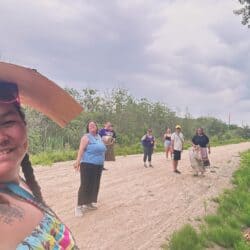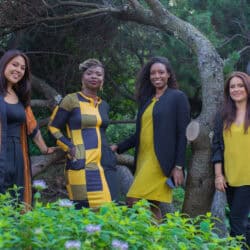While there is increasing attention to DEI in the charitable and non-profit sector, there are unexplored opportunities for creating positive change, from everyday operations to supply chain practices – a phenomenon dubbed “supplier diversity.”
Picture this scenario: You’re preparing to hold an in-person event, and the cherry on top is providing your guests with an exceptional culinary experience. Now comes the crucial moment: sourcing quotes from catering companies and suppliers. What will be your approach?
Alexandra Theroux is familiar with this question. She’s the director of operations at Impact Organizations of Nova Scotia (IONS), an organization that advocates for a shared voice among the province’s 6,400 registered non-profits, charities, and community interest companies. IONS has organized several events and workshops over the past three years, and one thing has been constant: Theroux’s intentional approach to ensuring that the organization seeks Black-owned or culturally diverse caterers for their events.
“You get to create culturally affirmative experiences for the people that you’re inviting to a conversation,” Theroux says of the benefits. And, she adds, “you get to eat some really cool stuff.” Theroux also makes sure the same lens applies to other suppliers, too, including consultants or facilitators.
It may seem a simple act, but making intentional choices about suppliers speaks volumes about the diversity, inclusion, and equity (DEI) strategies IONS is applying – even to a less obvious area of their organization.
You get to create culturally affirmative experiences for the people that you’re inviting to a conversation.
Alexandra Theroux, Impact Organizations of Nova Scotia
Historically, DEI has been implicitly linked to human resources. Organizations have typically focused on ensuring that they have diverse workforces or boards. But what about other areas that are not so evident, like procurement? While there is increasing attention to DEI in the charitable and non-profit sector, there are unexplored opportunities for creating positive change, from everyday operations to supply chain practices – a phenomenon dubbed “supplier diversity.”
A 2015 survey by the Canadian Centre for Diversity and Inclusion (CCDI) found that 39% of Canadian organizations had implemented a supplier diversity program or initiative. Although strides have been made, many Canadian organizations are only now turning their attention to this issue.

The Philanthropist Journal spoke with six workforce leaders in the non-profit and charitable sector to get their perspectives – each of them at different stages in their supplier diversity initiatives. We were curious how non-profits across Canada are incorporating DEI principles into not-so-obvious corners of their organizations. Some have made significant progress, some are considering it, and others don’t yet have a formal program.
Theroux, for one, is not letting a lack of process or policy get in the way. “It shouldn’t stop you from trying,” she says.
What is supplier diversity?
Every purchase has a social, environmental, cultural, and economic impact – whether intended or not – says Elizabeth Chick-Blount, chief executive officer at Buy Social Canada, a non-profit dedicated to redefining how goods and services are bought and sold. In her words, “the collective effort of leveraging social value from purchasing has a powerful and positive ripple effect in our communities.” And that, she says, is why supplier diversity programs matter.
In the CCDI’s Supplier Diversity in Canada report, the Chartered Institute of Procurement and Supply defines supplier diversity as initiatives that seek to increase the participation of diverse businesses, including those owned by racialized people and women, in providing goods and services. Diverse-owned businesses have traditionally been defined as those 51% owned and operated by someone from an equity-deserving group.
The collective effort of leveraging social value from purchasing has a powerful and positive ripple effect in our communities.
Elizabeth Chick-Blount, Buy Social Canada
Supplier diversity can benefit the community in numerous ways, Chick-Blount says. For example, diversity of ownership in supply chains can address issues of racialized poverty and social exclusion. Purchasing from a social enterprise may create employment for a person facing barriers, such as a new immigrant or a person with a disability. Indigenous procurement can mean economic and cultural advancement and can support socioeconomic reconciliation.
These benefits mirror the challenges non-profits are trying to solve. Hence, organizations’ buying decisions are a potent way to expand their impact and tackle difficult social and environmental problems.
CCDI’s research found that applying a DEI lens to procurement brought several advantages, including increased economic capacity and prosperity in the community. However, supplier diversity programs can also face challenges in their execution. Some organizations may be reluctant to stop working with non-minority business suppliers that they already do business with or may lack the resources to oversee the program. There may also be additional costs related to establishing and managing supplier diversity programs.
Supplier diversity is iterative – there is no hard or fast rule
For Bruce MacDonald, president and CEO of Imagine Canada, a national charitable organization that helps Canadian charities and non-profits serve people and communities better, progress over perfection has been the guiding principle. Even though Imagine Canada doesn’t have an official supplier diversity program, and doesn’t buy products or supplies often, it has been expanding its network of HR consultants to include more diverse views. “We’ve expanded our list of two suppliers to now five suppliers. The last three have experience and knowledge of working with more diverse staff and workplaces, which is what ours is becoming,” Macdonald says. “We don’t have it as a goal, but we’re doing the work.”
We don’t have it as a goal, but we’re doing the work.
Bruce MacDonald, Imagine Canada
Courtney Mo, director of community impact at Momentum, a Calgary organization that works with individuals and community partners to build a more inclusive local economy, says that “diversity has only recently moved into our conversations around procurement.” Momentum helped create the social procurement questionnaire for the City of Calgary, and it has also made conscious efforts to support local businesses or bring the supply chain closer to home and focus on businesses that have a positive social impact. “Our commitment extends to supporting locally owned businesses, small enterprises, Momentum business program graduates, and social enterprises, many of which are owned by individuals from diverse backgrounds,” Mo says.
Supplier diversity can often be associated with other progressive initiatives. CCDI’s survey found that organizations with initiatives for corporate social responsibility or sustainability were more likely to have supplier diversity programs as well.
Environment Funders Canada (EFC), a network that catalyzes more than 75 philanthropic funders to support the transition to a more sustainable world, has taken a staggered approach to applying a DEI lens to its procurement practices. “We inquire with people within our network and on LinkedIn for recommendations on suppliers as needed,” says Devika Shah, EFC’s executive director, in an email. “We are sure to ask people who we think will be able to recommend diverse suppliers.”
We are being proactive and conscious about our outreach to potential applicants to ensure a diverse range of suppliers are considered.
Devika Shah, Environment Funders Canada
“We vet all suppliers equally . . . to determine who is best suited to meet our needs within the parameters we have prioritized,” she adds, noting that quality of work, budget, or other concerns can factor in. Based on that process, the organization picks the best candidate. “Only if we have two equally qualified candidates do we then prioritize diversity considerations in making the final selection,” Shah says. “By adopting this strategy, we are being proactive and conscious about our outreach to potential applicants to ensure a diverse range of suppliers are considered.”
The approach has been effective so far. It “has resulted in approximately 50% of the contractors/suppliers we work with identifying with one or more of these identity categories: BIPOC, persons with disabilities, LGBTQ2S+,” Shah says.
Organizations have to make sure they are walking the talk
Over the years, DEI has become increasingly talked about as organizations work to ensure that DEI principles are upheld. But that doesn’t always translate into meaningful action. Imagine Canada’s July 2023 study on equity, diversity, and inclusion concluded that “while most nonprofit leaders support equity, diversity and inclusion, far fewer pursue it with deep intentionality.”
Paul Taylor, co-founder of Evenings & Weekends Consulting, shares the same sentiment and advocates for organizations to walk the talk. “If an organization wants to commit to address injustice, they have to recognize the connections between racial justice and economic justice and put their money where their mouths are. They have to make sure that they’re being intentional around who they’re engaging with and take action that supports what they have advocated for,” he says.
If an organization wants to commit to address injustice, they have to recognize the connections between racial justice and economic justice and put their money where their mouths are.
Paul Taylor, Evenings & Weekends Consulting
Taylor and his business partner, Laëtitia Eyssartel, offer consulting services to non-profits. Taylor stresses that it is important for non-profit leaders to avoid tokenization and merely “checking boxes” in their DEI strategies. Instead, he says, they need to be intentional to make a lasting impact. “Approaches such as reaching out to racialized staff in the organizations when drawing up a supplier list might be more far-reaching,” he says. “So for us, our approach is around how do we centre the people that are most affected by the outcome of our work. We adopt a listening-based approach and hear from the staff working within their organization, particularly racialized staff if it’s an issue around equity, or focus on equity-deserving communities.” He adds, “When an organization enlists our services, we collaborate closely with their employees, as we believe they hold the insights needed for meaningful progress.”
It’s not only about shifting resources, but also, whose knowledge and expertise is respected and trusted.
Paul Taylor
Embarking on the journey of supplier diversity may seem daunting, but organizations are not alone. Buy Social Canada provides valuable resources, including a directory of verified social enterprises and learning materials, supporting organizations in their unique journeys.
DEI in procurement can vary depending on the type of organization: some non-profits may prioritize buying goods, while others may focus on procuring services or a mix of both. Regardless of the focus, Taylor encourages organizations to engage with and learn from marginalized communities within their non-profits, rather than relying on external consultants. “It’s not only about shifting resources, but also, whose knowledge and expertise is respected and trusted,” he says.
CORRECTION: February 21, 2024
The original version of this story misquoted the comments Devika Shah provided by email, regarding Environment Funders Canada’s outreach to potential applicants (not applications) and the diversity of its suppliers (50% of its suppliers identify as BIPOC, persons with disabilities, or LGBTQ2S+, not BIPOC, persons with disabilities, and diverse groups).
This is the second piece from Stella Igweamaka, one of five writing fellows working with The Philanthropist Journal. (Her first was “Building a Sense of Belonging and Connection at Work in the Hybrid Era.”) The fellowship is focused on the future of work and working and was made possible through funding and support from the Workforce Funder Collaborative.


